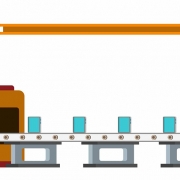The 5G revolution in Industry 4.0
The development of technologies that are taking place in the 21st century are driving the rise of smart and automated industries to ever higher levels. However, and despite all these developments, connectivity remains an important barrier to getting the most out of Industry 4.0.
Even today’s most advanced factories still rely heavily on Wi-Fi networks that have drawbacks such as interference in dense environments and complex connections that are not at all easy to manage in large industrial environments.
The arrival of 5G
The good news is that the emergence of advanced connectivity technologies, such as 5G, comes to provide manufacturers with a reliable alternative. It is a fact that will allow critical communications, such as the wireless control of manufacturing machines and robots, which will bring about the potential of Industry 4.0, including the massive arrival of 5G-specific IoT devices.
Still, for this to be possible, communications between machines have to be secure, reliable and continuous. To achieve this, 5G supports three fundamental types of communication: enhanced mobile bandwidth, massive machine-type communications, and ultra-reliable low-latency communications.
Connectivity is a fundamental component in Industry 4.0 and the promise of digital transformation that it offers is a huge leap forward. What 5G connectivity will allow is, above all, to improve the flexibility, versatility, usability and efficiency of future smart factories, integrate the Internet of Things (IoT) in the industry and facilitate continuous integration processes to along the value chain.
Achieving all these goals will depend, to a large extent, on the technical performance of 5G and its ability to support large volumes of data, an enormous density of connections, a growing demand for precision and reliability, very low latencies and increasingly optimized energy consumption. . In addition, all this must take place in secure environments in which data control and privacy are guaranteed.
Therefore, the arrival of 5G will offer the industry much greater connectivity between machines, people and objects, which will be a means to achieve the objectives of flexibility in production, worker access to information in real time and automation. of processes thanks to the successful implementation of autonomous vehicles and robots.

Faster and more reliable video speeds
With higher network speeds, it will be easier to access video usage. Manufacturers that use remote training, video conferencing, and video for sales and marketing functions will see increased productivity. This means better communications and fewer problems with video buffering and latency. Whether hiring new employees or holding virtual meetings, manufacturers will be able to work much faster.
In addition, 5G will allow more real-time manufacturing monitoring. Along with the growing centralized cloud-based software around Artificial Intelligence and computing power, video streams could be monitored for defects, assembly, temperature, or security issues. Instead of using Wi-Fi, 5G will facilitate mobility and may be a better option in environments with non-stationary processes.
Better indoor connectivity
Manufacturers will also be hit when it comes to indoor connectivity challenges. It is very common for workers to report that they frequently have connectivity problems. Mobile coverage is essential, as employees constantly need to rely on it.
Mobile operators are already planning massive infrastructure upgrades on their towers, and due to the 5G frequency bands, they will also need more points of connectivity than ever before. This will result in even better connectivity indoors, which is a top priority for manufacturers. Whether it’s a worker taking inventory on a mobile device or tracking machine maintenance, having better connectivity indoors will lead to more efficient plants.
Security risks
With the influx of 5G data speeds, more cyberattacks could occur, resulting in data leaking more easily. This would put numerous plant devices at risk if they are not properly equipped to mitigate these security hazards.
With the adoption of 5G, there is a good time to review the precautions to take to protect company data, such as multiple authentication logins on devices for applications that encrypt or erase data if any device is lost or get compromised.
Improved remote support
Lower latency aspects will make remote support a reality for a wide range of critical use cases, which were previously not possible to occur. From remote equipment control to data analysis, remote work will be a much smoother process. Faster speeds will blur the lines between remote and on-site as quality support will not be limited by location.
With 5G, the speed of the Internet will reach a new level. Connectivity will improve and help make plant operations more efficient. From remote support to inventory tracking, mobile tasks will be made easier thanks to the adoption of 5G. However, these faster speeds can lead to higher security risks. 5G presents a great opportunity for manufacturers, but only if they can adequately protect their devices.









